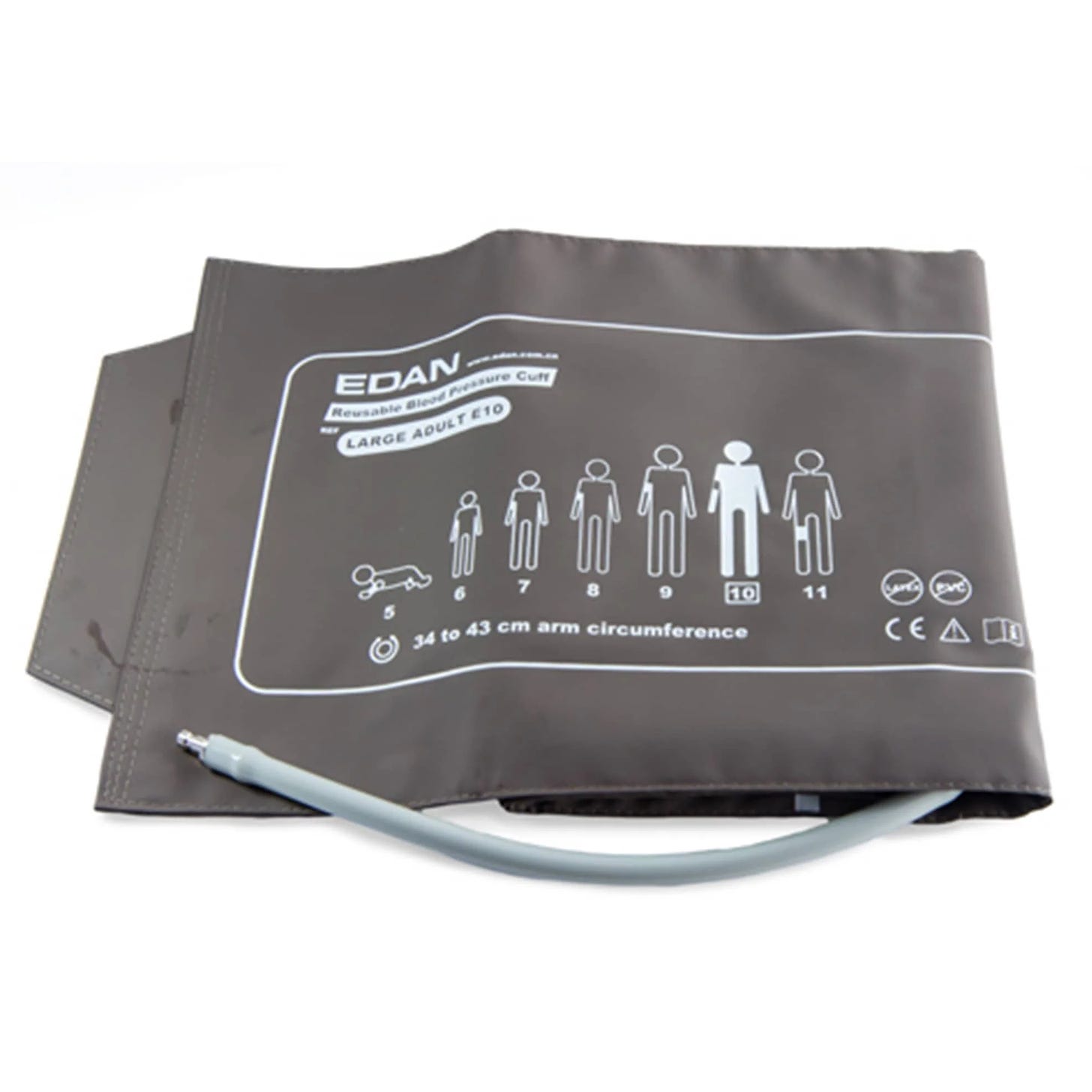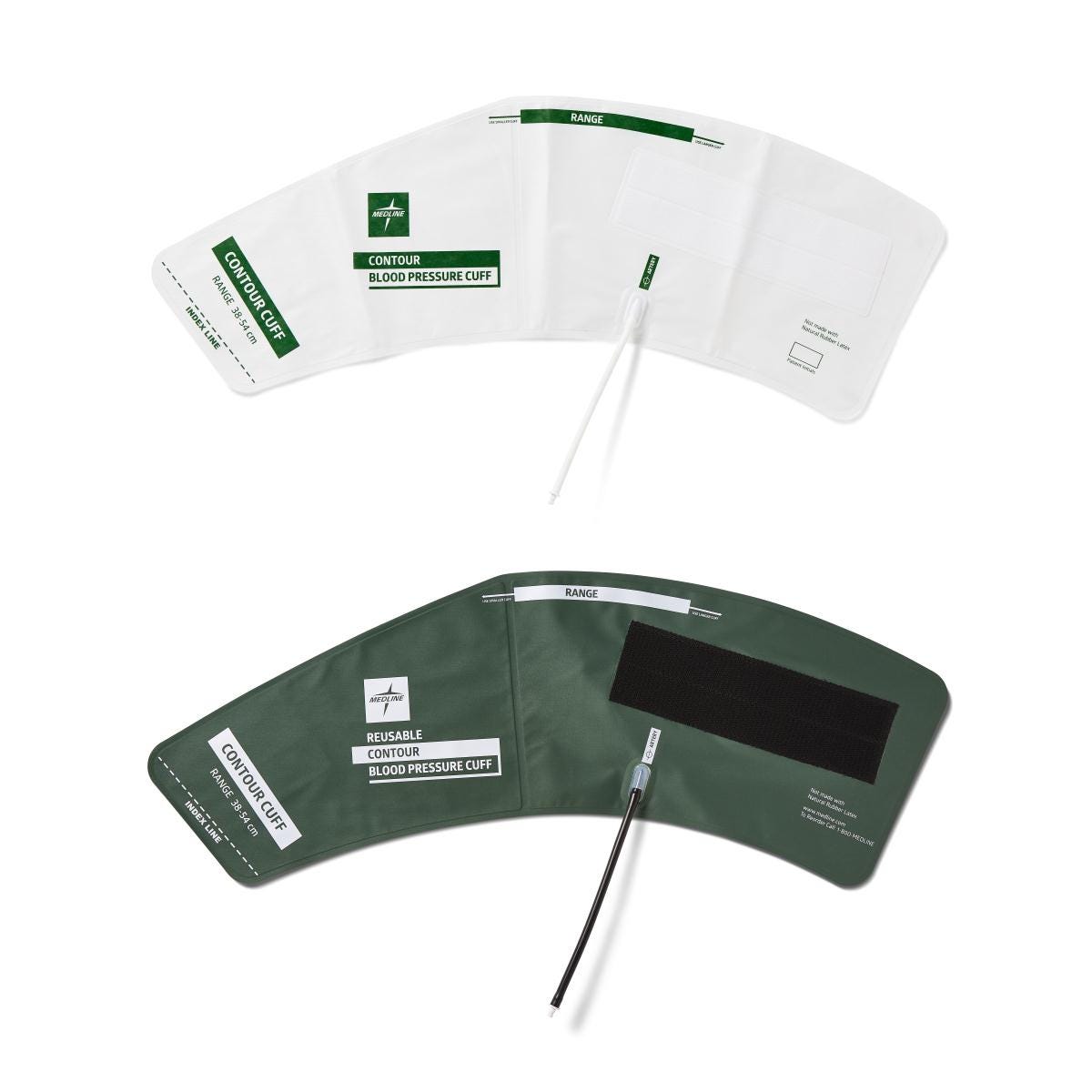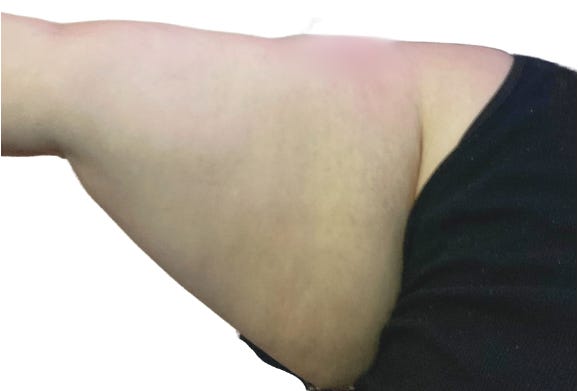This is the Weight and Healthcare newsletter! If you like what you are reading, please consider subscribing and/or sharing!
In my recent quick guide to creating a size-inclusive office, I mentioned troncoconical blood pressure cuffs and I heard from a number of people in healthcare who said that they had never heard of them so I thought I’d write a follow-up piece.
The fact that so many people haven’t heard of these speaks to the nature of weight stigma in healthcare. Blood pressure cuffs were made for lower-weight people and higher-weight people have been asked to make due with options that are known to be less accurate – from wrist cuffs to thigh cuffs (the name of which is already a problem since it tells you that it’s not meant for upper arms). It’s especially egregious that this happens considering that cuffs that are specifically built for higher-weight people exist, but I’m getting ahead of myself.
Before I get too far into this, I want to be clear that cuff size is far from the only part of taking an accurate blood pressure. The aspects of taking proper blood pressure are well documented and include the patient resting for five minutes prior to the reading, and during the reading seating the patient comfortably in a chair that has back support with their feet flat on the floor and legs uncrossed, fully supporting the arm at chest height, not talking (and certainly not giving unsolicited weight loss advice, which has happened to me personally,) then there’s using a properly sized cuff against bare skin. There are also systemic issues involved here, often the people taking vitals are rushed to get them done as quickly as possible, sometimes sacrificing accuracy. That said, for today we’re focusing on cuff size.
Let’s start with an understanding of exactly how taking blood pressure works:
From the aptly named “In brief: What is blood pressure and how is it measured?” (updated 2019)
A sphygmomanometer has three parts:
· a cuff that can be inflated with air,
· a pressure meter (manometer) for measuring air pressure in the cuff, and
· a stethoscope for listening to the sound the blood makes as it flows through the brachial artery (the major artery found in your upper arm).
The scale of the pressure meter ranges from 0 to 300 mmHg. The pressure meter has a rubber pump on it for inflating the cuff and a button for letting the air out.
To measure blood pressure, the cuff is placed around the bare and stretched out upper arm, and inflated until no blood can flow through the brachial artery. Then the air is slowly let out of the cuff.
As soon as the air pressure in the cuff falls below the systolic blood pressure in the brachial artery, blood will start to flow through the arm once again. This creates a pounding sound when the arteries close again and the walls of the vessels hit each other after a heart beat. The sound can be heard by placing the stethoscope close to the elbow. Right when you start to hear this pounding for the first time you can read your systolic blood pressure off the pressure meter.
The pounding sound stops when the air pressure in the cuff falls below the diastolic blood pressure in the brachial artery. Then the blood vessels remain open. Right when the pounding stops, you can read the diastolic blood pressure off the pressure meter.
The blood pressure cuffs we are used to seeing are referred to as rectangular and look like this:
But they aren’t the only kind of blood pressure cuff.
There is also another type of cuffs that go by various names: conical/troncoconical/contour/”bariatric” cuffs that look like this:
They work best for arms that look like this:
A study from 1985, (Maxwell GF, Pruijt JF, Arntzenius AC. Comparison of the conical cuff and the standard rectangular cuffs. Int J Epidemiol 1985; 14:468–472) found that when people at the higher end of the weight spectrum had their blood pressure taken using a conical cuff they obtained lower systolic and diastolic pressure readings than with the rectangular cuffs.
They also pointed out that this was not remotely a new issue. “Since the beginning of this century, when Von Recklinghausen (1901) first observed that a too narrow sphygmomanometer cuff resulted in blood pressure measurements that were systematically too high, much work has been done in search of the correct size(s) for cuffs for clinical use.”
In fact, in 1974, Steinfeld et al (Updating sphygmomanometry. Editorial.) “proposed using a trapezoidal bladder when measuring blood pressure in ob*se patients, which would be better suited to the often conically shaped ob*se limbs”
Then, in 1978 Huige et al. developed a cone-shaped cuff. (Influence of cuff size and design on indirect blood pressure measurement and Onderzoek naar de betrouwbaarheid van de auscultatoire bloeddrukmeting aan overwegend dikke bovenarmen. Introductie van een conische manchet.) which they found “proved to be more accurate in intra-arterial comparisons.”
Maxwell et al conclude (again, published in 1985) that “The conical cuff seems to be a practical and more accurate cuff for subjects with ob*se upper arms and warrants further investigation.”
The ridiculous phrase “ob*se upper arms” aside, this seems like an important conclusion, but no change to blood pressure measurements seems to have happened.
In 2019, Palatini et al. published “Only troncoconical cuffs can provide accurate blood pressure measurements in people with s*ve*e ob*sity”
This was a small study of 33 subjects with arm circumferences of at least 42cm conducted by comparing readings between a standard cuff and a troncoconical cuff with the same length and width on the midpoint. The study included a control group of 33 participants with an upper arm circumference of less than 32cm.
They point out that conically shaped arms are frequently encountered in higher-weight patients, and may be a major source of inaccurate BP measurement because “when the proximal upper arm circumference is much larger than the circumference near the elbow, a cylindrical (rectangular) cuff will expand irregularly on the lower part of the arm making it impossible to perform an accurate BP measurement”
Their results state “In all ob*se participants, the upper arm shape was troncoconical (mean ± SD slant angle, 84.1 ± 1.4°). In this group, SBP and DBP differences between the troncoconical and the cylindrical cuff were -5.3 ± 4.0 and -3.0 ± 4.3 mmHg, respectively (P < 0.001/=0.01 versus controls). In the ob*se participants of the top BP quintile, the between-cuff SBP difference was -9.1 ± 5.1 mmHg. Arm slant angle was an independent predictor of the between-cuff SBP discrepancy (P = 0.003). When the cylindrical cuff was used, measurement with the pressure sensor showed a marked disagreement between the pressure in the cuff and the pressure transmitted to the arm (mean difference, -10.2 ± 5.2 mmHg) a difference, which increased with increasing level of the pressure pumped in the cuff.”
Said more simply in their conclusion, in those of the highest weights “cylindrical cuffs overestimate BP chiefly in people with high SBP [Systolic blood pressure] and thus only troncoconical cuffs should be used.”
Also in 2019, Saladini et al. published “Looking for the appropriate shape of cuffs to obtain accurate blood pressure measurements in obese subjects with large arms.”
They measured the arms of 777 adults, mean age 55.0 ± 16.9 years, 49.9% males, mean BMI 30.1 ± 9.7 kg/m2. (I want to point out that it’s not clear if People of Color were appropriately represented and they failed to include trans and nonbinary representation.)
They concluded “A tronco-conical cuff with an 85° slant angle should be used for BP measurement in subjects with extra-large arms. In addition, to properly fit the upper arm the cuff should have a more pronounced tronco-conical shape in the lower half, especially for ob*se women.”
In June 2023, Palantini et al. published a poster session called “Conical cuffs should be used as the reference standard for validation of blood pressure measuring devices in ob*se people with arm circumference of more than 42 cm.”
They concluded that in “people with arm size > 42 cm, a cylindrical cuff causes an important overestimation of BP measured with a tronco-conical cuff.” They suggested that for those with an arm size over 42 cm “should have a conical shape with an 85̊ slant angle.”
In August of 2023 JAMA published “Effects of Cuff Size on the Accuracy of Blood Pressure Readings” by Ishigami et al. They concluded “In this randomized crossover trial, miscuffing resulted in strikingly inaccurate BP measurements. This is particularly concerning for settings where 1 regular BP cuff size is routinely used in all individuals, regardless of arm size. A renewed emphasis on individualized BP cuff selection is warranted.”
However, despite information since at least the 1970’s and including the studies I just reviewed (which are not an exhaustive list,) Ishigami et al. failed to include any use or even mention the existence of troncoconical cuffs.
In somewhat good news, this prompted a letter to the editor in February 2024 from Marco Zuin and Gianluca Rigatelli, stating, in part:
“In patients having a troncoconical shape of the upper arm, the use of cylindrical cuff during automated BP measurements may overestimate both systolic and diastolic BP (≥10 and 8 mm Hg, respectively), amplifying the BP measurement error. Therefore, as a general recommendation, troncoconical cuffs should be used for BP measurement in individuals with large and/or troncoconical arms.”
So what is to be done?
First, given the importance placed on blood pressure as a vital sign taken at almost every appointment, there should be a desire (and time dedicated) to make sure that patients of all sizes receive proper blood pressure measurements.
It would also be nice to have data from larger studies and to stop using unscientific terms like “extra-large arms” or “ob*se upper arms” and get some clarity. Like much of the healthcare system, sphygmomanometers were created based on thin bodies and despite information floating around since the 1970’s there hasn’t seemed to be much interest in including higher-weight people.
For now, any healthcare facility that takes blood pressure should consider acquiring troncoconical cuffs for patients with conically shaped arms. If their medical supply companies don’t offer them, they should pressure them to do so and/or find suppliers that do. Medline, Mainline Medical, 4MD Medical all offer them (full disclosure – I have no financial ties to any of these companies or any medical supply company.)
In general, we need tremendous external and internal pressure on the healthcare industry to create healthcare experiences that are evidence-based and inclusive for people of all sizes.
Did you find this post helpful? You can subscribe for free to get future posts delivered direct to your inbox, or choose a paid subscription to support the newsletter (and the work that goes into it!) and get special benefits! Click the Subscribe button below for details:
Liked the piece? Share the piece!
More research and resources:
https://haeshealthsheets.com/resources/
*Note on language: I use “fat” as a neutral descriptor as used by the fat activist community, I use “ob*se” and “overw*ight” to acknowledge that these are terms that were created to medicalize and pathologize fat bodies, with roots in racism and specifically anti-Blackness. Please read Sabrina Strings’ Fearing the Black Body – the Racial Origins of Fat Phobia and Da’Shaun Harrison’s Belly of the Beast: The Politics of Anti-Fatness as Anti-Blackness for more on this.







Thank you for this breakdown!! I had no idea. I went through both EMT and CNA training in the mid-1990’s, and the effects of BP on cuff size were heavily stressed (it was even part of my CNA exam), but a troncoconical cuff was NEVER mentioned.
And now today in 2024, with fat conical arms, I am just now learning about it. Amazing.
I wonder how many fat people have been treated inappropriately for HPB because of improper cuffs, and improper cuffs combined with the stress of anti-fatness in medical settings. And how many more had negative reactions to the BP meds they didn’t need.
THANK YOU!!!!! Immediately going to request these for our hospital. It drives me nuts taking blood pressures on wrists and ankles for people with peripheral vascular disease and other conditions that affect circulation. The little arrows on the cuff need to be over the brachial artery (and that's where you put the stethoscope if you do it manually, which is more accurate); the longer cuffs may fit the larger part of the upper arm, but there's usually a huge gap around the bottom edge of the cuff WHICH IS THE MOST IMPORTANT PLACE TO GET A GOOD FIT. And if you try to make a conical shape by just slanting the rectangular cuff, it's not accurate and usually just busts through the velcro. In the ICU, we do so many interventions based on blood pressure, and we owe it to our larger patients to be as accurate and diligent as possible.